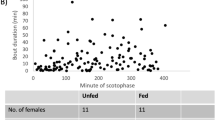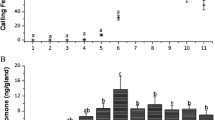Abstract
Two closely related plusiinae moths, Autographa gamma Linnaeus and Cornutiplusia circumflexa Linnaeus, are sympatric in Israel. Both species use identical sex pheromone components but in different ratios, and do not attempt to mate with each other. In addition to the effective reproductive separation by their sex pheromones, the sexual behavior of both species was compared to determine whether the lack of selection pressure might create additional barriers to cross-attraction and cross-mating. We found the gamma moth to be sexually active almost equally throughout the scotophase, whereas the sexual activity of C. circumflexa was limited to a short period at the end of the scotophase when most of the gamma moths had already mated. Higher levels of calling were observed with older females. There was a close relationship between pheromone titer and calling activity in both species.





Similar content being viewed by others
References
J. Delisle (1992) ArticleTitleAge related changes in the calling behaviour and the attractiveness of the oblique-banded leafroller virgin females, Choristoneura rosaceana, under different constant and fluctuating temperature conditions Entomol. Exp. Appl. 63 55–62 Occurrence Handle10.1007/BF00350346
J. Delisle (1995) ArticleTitleEffect of male and female age on the mating success of the obliquebanded leafroller Choristoneura rosaceana (Lepidoptera: Tortricidae) under different ecological conditions J. Insect Behav. 8 781–799 Occurrence Handle10.1007/BF02009506
J. Delisle J. N. McNeil (1986) ArticleTitleThe effect of photoperiod on the calling behavior of virgin females of the true armyworm, Pseudaletia unipuncta (Haw.) (Lepidoptera: Noctuidae) J. Insect Physiol. 32 199–206 Occurrence Handle10.1016/0022-1910(86)90059-4
J. Delisle J. N. McNeil (1987) ArticleTitleCalling behavior and pheromone titer of the true armyworm Pseudaletia unipuncta (Haw.) (Lepidoptera: Noctuidae) under different temperature and photoperiod conditions J. Insect Physiol. 33 315–324 Occurrence Handle10.1016/0022-1910(87)90119-3
J. Delisle L. Royer (1994) ArticleTitleChanges in pheromone titer of oblique-banded leafroller, Choristoneura rosaceana, virgin females as a function of time of day, age, and temperature J. Chem. Ecol. 20 45–69 Occurrence Handle10.1007/BF02065990
A. P. Socorro ParticleDel P. C. Gregg (1997) ArticleTitleCalling behaviour in M. convecta females under different temperature and photoperiodic conditions Physiol. Entomol. 22 20–28
H. Dingle (1972) ArticleTitleMigration strategies of insects Science 175 1327–1355
E. Dunkelblum S. Gothilf (1983) ArticleTitleSex pheromone components of the gamma moth, Autographa gamma (L.) (Lepidoptera: Noctuidae) Z. Naturforsch. 38C 1011–1014
E. Dunkelblum M. Mazor (1993) ArticleTitleChemical characterization and species specificity of sex pheromones of Plusiinae moths in Israel Arch. Insect Biochem. Physiol. 22 413–424 Occurrence Handle10.1002/arch.940220309
E. Dunkelblum M. Kehat M. Harel D. Gordon (1987) ArticleTitleSexual behavior and pheromone titer of the Spodoptera littoralis female moth Entomol. Exp. Appl. 44 241–247 Occurrence Handle10.1007/BF00369185
R. P. Edmonds J. H. Borden N. P. D. Angerelli A. Raul (2000) ArticleTitleA comparison of the developmental and reproductive biology of two soybean pod borers, Etiella spp. in Indonesia Entomol. Exp. Appl. 97 137–147 Occurrence Handle10.1023/A:1004099706718
A. A. M. Etman (1989) ArticleTitleOn some factors influencing the population dynamics of Spodoptera littoralis (Boisd.), Sp. exigua (Hbn.), Syngrapha circumflexa (L.), Autographa gamma L., and Heliothis armigera (Hbn.) (Lep., Noctuidae) in Egypt J. Appl. Entomol. 108 182–190
M. L. Evenden B. G. Spohn A. J. Moore R. F. Preziosi K. F. Haynes (2002) ArticleTitleInheritance of evolution of male response to sex pheromone in Trichoplusia ni (Lepidoptera: Noctuidae) Chemoecology 12 53–59 Occurrence Handle10.1007/s00049-002-8326-0
K. Fisher (1938) ArticleTitleMigrations of the silver-Y moth (Plusia gamma) in Great Britain J. Anim. Ecol. 7 230–247
C. Gemeno K. F. Haynes (2000) ArticleTitlePeriodical and age-related variation in chemical communication system of black cutworm moth, Agrotis ipsilon J. Chem. Ecol. 26 329–342 Occurrence Handle10.1023/A:1005468203045
I. Ghizdavu F. Hodosan N. Popovici A. Botar A. Barabas (1979) ArticleTitleA sex attractant for Autographa (Plusia) gamma L. moth Rev. Roum. Biol., Biol. Anim. 24 87–90
F. A. Harakly (1975) ArticleTitleBiological studies on the loopers Autographa gamma (L.) and Cornutiplusia circumflexa (L.) (Lep., Noctuidae) infesting truck crops in Egypt Z. Angew. Entomol. 78 285–290
J. K. Hill A. G. Gatehouse (1992) ArticleTitleEffects of temperature and photoperiod on development and pre-reproductive period of the silver Y moth Autographa gamma (Lepidoptera: Noctuidae) Bull. Entomol. Res. 82 335–341
M. A. Howlader G. H. Gerber (1986) ArticleTitleEffects of age, egg development, and mating on calling behavior of the bertha armyworm, Mamestra configurata (Lepidoptera: Noctuidae) Can. Entomol. 118 1221–1230
C. G. Johnson (1960) ArticleTitleA basis for a general system of insect migration and dispersal by flight Nature 186 348–350
M. Kamimura S. Tatsuki (1993) ArticleTitleDiel rhythm of calling behavior and pheromone production of oriental budworm moth, Helicoverpa assulta (Lepidoptera: Noctuidae) J. Chem. Ecol. 19 2953–2963 Occurrence Handle10.1007/BF00980595
I. J. Kitching (1987) ArticleTitleSpectacles and silver Ys: A synthesis of the systematics, cladistics, and biology of the Plusiinae (Lepidoptera: Noctuidae) Bull. Br. Mus. Nat. Hist., Entomol. 54 75–261
R. Kou Y. Chow (1987) ArticleTitleCalling behavior of the cotton bollworm, Heliothis armigera (Lepidoptera: Noctuidae) Ann. Entomol. Soc. Am. 80 490–493
Y.-B. Liu K. F. Haynes (1994) ArticleTitleEvolution of behavioral responses to sex pheromones in mutant laboratory colonies of Trichoplusia ni J. Chem. Ecol. 20 231–238 Occurrence Handle10.1007/BF02064433
C. Löfstedt (1990) ArticleTitlePopulation variation and genetic control of pheromone communication systems in moths Entomol. Exp. Appl. 54 199–218 Occurrence Handle10.1007/BF00186789
C. Löfstedt B. S. Hansson M. Tóth G. Szöcs V. Buda M. Bengtsson N. Ryrholm M. Svensson E. Priesner (1994) ArticleTitlePheromone differences between the sibling taxa Diachrysia chrysitis and D. tutti (Kostrowicki, 1961) (Lepidoptera: Noctuidae) J. Chem. Ecol. 20 91–109 Occurrence Handle10.1007/BF02065993
R. Marcus E. Peritz K. R. Gabriel (1976) ArticleTitleOn closed testing procedures with special reference to ordered analysis of variance Biometrika 63 655–660
M. Mazor E. Dunkelblum (1992) ArticleTitleRole of sex pheromone composition in behavioral reproductive isolation between Autographa gamma (L.) and either Trichoplusia ni (Hubner) or Chrysodeixis chalcites (Esp.) (Lepidoptera: Noctuidae: Plusiinae) J. Chem. Ecol. 18 2373–2384 Occurrence Handle10.1007/BF00984956
M. Mazor M. Harel S. Levski E. Dunkelblum (1991) ArticleTitleSex pheromone components of female Cornutiplusia circumflexa Entomol. Exp. Appl. 60 167–172 Occurrence Handle10.1007/BF00177037
J. N. McNeil (1986) ArticleTitleCalling behavior: can it be used to identify migratory species of moth? Fla. Entomol. 69 78–84
T. Ono S. Orita (1986) ArticleTitleField trapping of the potato tuber moth, Phthorimaea operculella (Lepidoptera: Gelechiidae), with the sex pheromone Appl. Entomol. Zool. 21 632–634
D. E. Pedgley S. Yathom (1993) ArticleTitleWindborne moth migration over the Middle East Ecol. Entomol. 18 67–72
A. K. Raina W. H. Klun E. A. Stadelbacher (1986) ArticleTitleDiel periodicity and effect of age and mating on the female sex pheromone titer in Heliothis zea (Lepidoptera: Noctuidae) Ann. Entomol. Soc. Am. 79 128–131
A. K. Raina J. C. Davis E. A. Stadelbacher (1991) ArticleTitleSex pheromone production and calling in Helicoverpa zea (Lepidoptera: Noctuidae): Effect of temperature and light Environ. Entomol. 20 1451–1456
C. Schal R. T. Cardé (1986) ArticleTitleEffects of temperature and light on calling in the tiger moth Holomelina lamae (Freeman) (Lepidoptera: Arctiidae) Physiol. Entomol. 11 75–87
H. H. Shorey R. L. Hale (1965) ArticleTitleMass rearing of the larvae of nine noctuid species on a simple artificial medium J. Econ. Entomol. 58 522–524
H. H. Shorey S. U. McFarland L. K. Gaston (1968) ArticleTitleSex pheromones of noctuid moths, XIII. Changes in pheromone quantity, as related to reproductive age and mating history, in females of seven species of Noctuidae (Lepidoptera) Ann. Entomol. Soc. Am. 61 372–376
R. Snir E. Dunkelblum S. Gothilf I. Harpaz (1986) ArticleTitleSexual behavior and pheromone titer in the tomato looper, Plusia chalcites (Esp.) (Lepidoptera: Noctuidae) J. Insect Physiol. 32 735–739 Occurrence Handle10.1016/0022-1910(86)90116-2
S. R. Swier R. W. Rings G. J. Musick (1977) ArticleTitleAge-related calling behavior of the black cutworm, Agrotis ipsilon Ann. Entomol. Soc. Am. 70 919–924
G. Szöcs M. Tóth (1979) ArticleTitleDaily rhythm and age dependence of female calling behavior and male responsiveness to sex pheromone in the gamma moth, Autographa gamma (L.) (Lepidoptera: Noctuidae) Acta Phytopathol. Entomol. Hung. 14 453–459
N. Tomescu G. H. Stan C. Roman I. Coroiu V. Chiş A. Onişor (1985) ArticleTitleMating activity in Plusia gamma L. and Amathes C-nigrum (Lepidoptera: Noctuidae) Rev. Roum. Biol. Anim. 30 17–23
M. Tóth G. Szöcs B. Majoros T. E. Bellas L. Novák (1983) ArticleTitleExperiments with two-components sex attractant of the silver Y moth (Autographa gamma L.) and some evidence for the presence of both components in natural female sex pheromone J. Chem. Ecol. 9 1317–1325 Occurrence Handle10.1007/BF00994800
J. J. Turgeon J. N. McNeil (1982) ArticleTitleCalling behavior of the armyworm Pseudaletia unipuncta Entomol. Exp. Appl. 31 402–408
R. P. Webster R. T. Carde (1982) ArticleTitleRelationships among pheromone titer, calling, and age in the omnivorous leafroller moth (Platynota stultana) J. Insect Physiol. 28 925–933 Occurrence Handle10.1016/0022-1910(82)90108-1
E. P. Wiltshire (1990) ArticleTitleAn illustrated annotated catalogue of the macro-Heterocera of Saudi Arabia Fauna Saudi Arab. 11 91–250
S. Yathom E. Rivnay (1968) ArticleTitlePhenology and distribution of Phytometrinae in Israel Z. Angew. Entomol. 61 1–16
Acknowledgements
We thank Prof. J. N. McNeil for his constructive comments which helped with the data analysis, and the late Prof. K. R. S. Ascher and Prof. R. Galun for useful comments on previous drafts of this manuscript. We also thank Dr. A. Genizi, Dr. R. Marcus, and Mrs. M. Zarchi for help with statistical analyses.
Author information
Authors and Affiliations
Corresponding author
Additional information
Contribution from the Agricultural Research Organization (ARO), No. 51904
Rights and permissions
About this article
Cite this article
Mazor, M., Dunkelblum, E. Circadian Rhythms of Sexual Behavior and Pheromone Titers of Two Closely Related Moth Species Autographa gamma and Cornutiplusia circumflexa1. J Chem Ecol 31, 2153–2168 (2005). https://doi.org/10.1007/s10886-005-6082-7
Received:
Revised:
Accepted:
Published:
Issue Date:
DOI: https://doi.org/10.1007/s10886-005-6082-7




